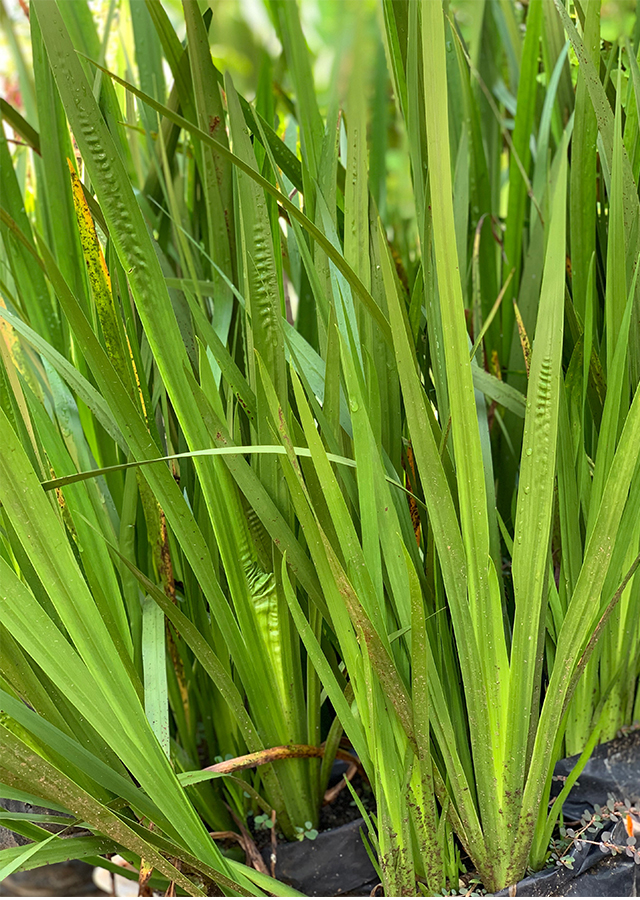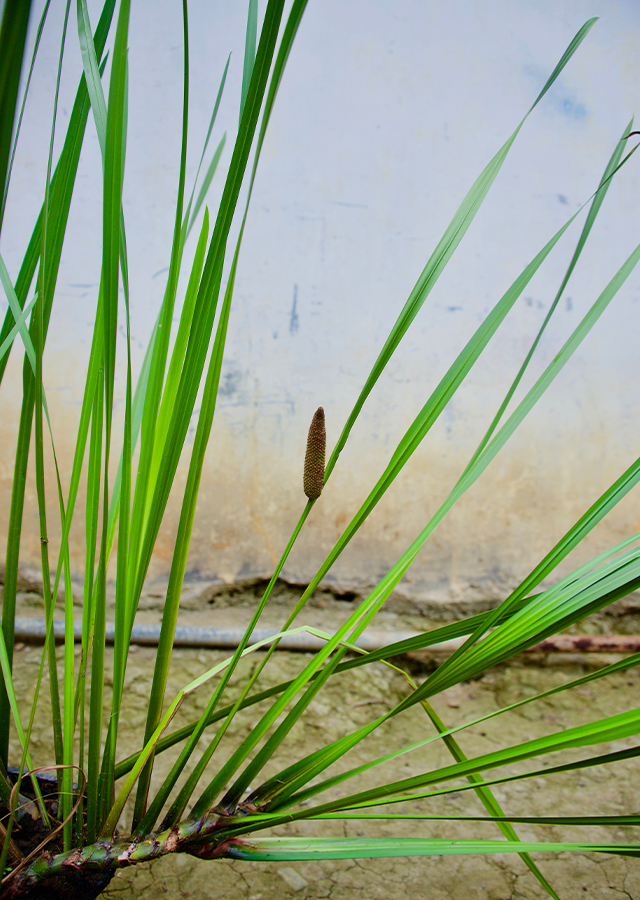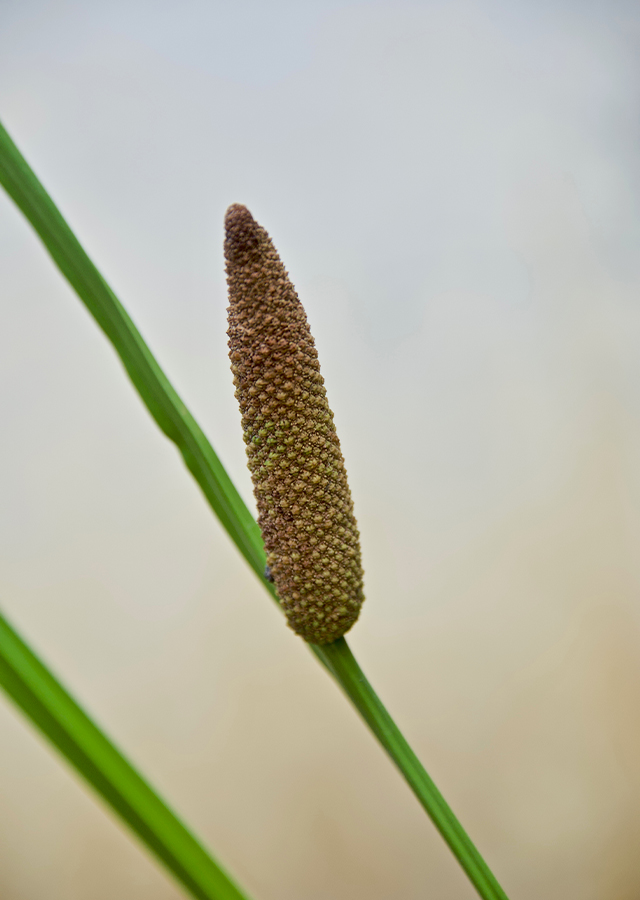Sweet Flag
Acorus calamus L.
Acoraceae
Location in our garden
Aquatic



Synonym
Calamus aromaticus Garsault
Habitus
Herbaceous. A herbaceous, aquatic reed-like plant with tall, sword-shaped leaves. It grows to 1.5 m tall
Part Used
Leaves
Flowers
Rhizome
Growing Requirements
Full Sunshine
Habitat
Aquatic
Wetland
Riverbanks
Overview
The Sweet Flag, thought to have originated from Asia (India and China), is now rising in many parts of the world. As a tonic and stimulant, this plant has a long-standing reputation. It is also commonly used in Europe and the US as an essential herb in Ayurvedic medicine and has spread widely from the Caucasus through Western Asia and Siberia to China, India, and Southeast Asia. A great part of North America. Widely naturalized in other countries.
Vernacular Names
Bach (Indian-Bengali), Hang khao nam (Laos), Jerangau (Malay), Lubigan (Philippines), Kha chiang chee (Thai), Thủy xương bồ (Vietnamese), daringo, dringo, jerango (Indonesia).
Agroecology
Sweet flag is a widespread plant which can be found right through to the tropics from the cold temperate zone. It is tolerant of a wide range of environmental conditions, but it grows best in areas where daily temperatures range from 18 to 26 °C per year and can withstand 4 to 30 °C per year. The plant can withstand temperatures down to about -25 °C when dormant. Mean annual precipitation in the range of 700 to 2,000 mm is also preferred, but tolerates 430 to 4,200 mm. Succeeds in a wide range of soils, requiring a position in shallow water or in a very moist loamy soil. Requires a sunny position. Prefers a pH in the range of 5.5 to 6.5, tolerating 5 - 7.5.
Morphology
- Roots - long fibrous from the lower surface.
- Stem - rhizomatous, cylindrical up to 2.5 cm diameter, purplish brown to light brown.
- Leaves - ensiform or linear.
- Flowers - inflorescences are 3‒8 cm long, numerous, densely arranged, typically 3-merous.
- Fruit - a berry with a few pendulous seeds.
- Seeds - obconical, 2 mm long.
Cultivation
A. calamus can be propagated easily from pieces of rhizome.
Chemical Constituents
- The rhizomes: essential oils, glycoside, aserone, isocalamendiol, flavonoids, alkaloids, polyphenol, akoretina, kholina, kalameona, epi-isokalamendiol, siobunona, koronana, trimetil amina, saponins, aneurin. Leaves: essential oils, β-asarone, saponins, flavonoids.
- Aerial parts contain alkaloid, choline and luteolin and acorin glycosides.
Traditional Medicinal Uses
- Management of amebic dysentery, asthma, cough, embryopathy, epilepsy, fever, gastrointestinal flatulence, stomach ulcer, headache, stroke of heat, hyperacidity, lipoma, lumbago, throat lumps, mania, pneumonia, postpartum bleeding, stomachache, tonsillitis and tuberculosis, abdominal pain, bronchitis, childhood chronic diarrhoea, delirium, epilepsy, general fatigue, swelling, hysteria, worms in the ear; cancer, colic or dyspepsia, mouth diseases, pains in the liver and chest, remittent fevers, sore throat, stomatitis.
- Sweet flag has been an essential medicinal aid in India for stomach problems and children's colic.
- Sweet flag is used in Vietnam for the treatment of respiratory disorders (asthma, inflammation), rheumatism, remitting fevers, snake bites, and as a sedative.
- The rhizomes are commonly used externally in Indonesia and Malaysia to treat inflammation, rheumatism, lumbago and skin diseases, and internally after childbirth.
- Sweet flag is used in Brunei for the treatment of gastritis and diarrhoea and also as a poison antidote.
Part Used
Reference Sources
- Fern, Ken. (2019). Useful Tropical Plants. Acorus calamus. http://tropical.theferns.info/viewtropical.php?id=Acorus+calamus 16-07-2020.
- Chevallier, A. (2016). Encyclopedia of Herbal Medicine (3rd Ed.). DK Publishing. page 57.
- Motaleb,M.A.,Dr.Hossain, M. K., Dr. Alam, M. K., Al Mamun, M.M.A., and Sultana M. (2013). Commonly Used Medicinal Herbs and Shrubs by Traditional Herbal Practitioners. IUCN (International Union for Conservation of Nature). page 57.
- Pl@nt Use. (2016). Acorus calamus (PROSEA). https://uses.plantnet-project.org/en/Acorus_calamus_(PROSEA) 16-07-2020.
- Balakumbahan, R., Rajamani, K., Kumanan, K. (2010). Acorus calamus: An overview. Journal of Medicinal Plants Research vol. 4 (25): 2740‒2745.


